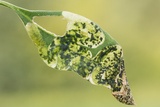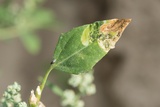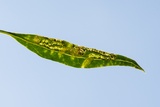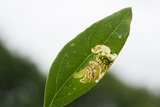Chrysoesthia drurella (Fabricius, 1775) Species
Last modified: Dec. 2, 2024, 2:47 p.m.
Observed in many areas in Belgium, in all provinces. Fairly common in the northern part and rare in the southern part of the country.
Details
- Classification
- Family: Gelechiidae > Subfamily: Apatetrinae > Tribus: Apatetrini > Genus: Chrysoesthia > Species: Chrysoesthia drurella
- Vernacular names
- Gloriemot (NL), Flame Crest, Fiery Miner (EN), Gänsefuß-Minierpalpenmotte (DE)
- Synonyms
- Chrysoesthia hermannella sensu auct.
- First mention in Belgium
- De Sélys-Longchamps E. 1844. Énumération des insectes Lépidoptères de la Belgique. — Mémoires de la Société royale des Sciences de Liége 2: 1–35. On page 25.
- Status
-
Native
Distribution
Imago
Wingspan 8–10 mm.
Museum specimens
No pictures yet!Specimens in nature
No pictures yet!Caterpillar
Head and prothoracic plate pale brown; abdomen yellowish or greenish white with numerous red spots dorsally, and laterally, becoming more red when mature (Gregersen & Karsholt 2022).
Mine
The larva makes a mine in the leaves of Chenopodium and Atriplex species. The gallery is sometimes contorted to such an extent that a blotch mine is formed at end.
Mine in dense coils, feces initially brownish, later green, completely filling the corridor.
See also bladmineerders.be
Bionomics
The larvae of the autumn generation hibernate full-fed in a cocoon which they leave before pupating. Pupation in detritus at ground level. Larvae of the spring generation do not form a cocoon and pupate in the mine.
The adults become active during late afternoon and later come occasionally to light.
Flight periods
The adults have been observed from mid-April towards early October in two generations a year.
Observed on
- Host plant (genera):
- Chenopodium and Atriplex
The larva lives exclusively on Chenopodium and Atriplex species (Chenopodiaceae).
Habitat
It inhabits open land and waste ground.




